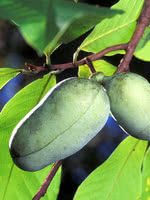Mon-Fri 9am - 5pm Mountain time
Pawpaw vs Golden Spice Pear
Asimina triloba
Pyrus Golden Spice
NOT AVAILABLE THIS SEASON - MIGHT RETURN
The Pawpaw tree produces delicious, sweet fruit with a unique banana-mango flavor. These oblong fruits start yellowish-green and mature to a dark brown in the fall. It is best to leave them on the tree until ripe, as they do not ripen well once picked. Pawpaws can be enjoyed fresh, in baking, or in ice cream.
Pawpaws produce the largest native fruit in North America. They typically grow as a small understory tree or large shrub on wooded slopes, in ravines, and along stream banks. They often spread through root suckers, forming dense thickets over time.
For fruit production to occur more than one genetically different Pawpaw tree is required. Our Pawpaw seedlings are grown from seed so they are all genetically different.
Note: Avoid eating the seeds and skin of the Pawpaw fruit as they can cause stomach pain for some individuals. Contact with the skin of the fruit can also result in skin irritation, so it is recommended to wear gloves during harvest. Plant this tree once. Due to its large tap root transplanting is not recommended.
Golden Spice Pear produces delicious fruit and has other features that make it a striking accent tree. It is one of the few pears that successfully grows on the Canadian prairies. In late August, small, yellow pears with a slight red overlay will ripen and be ready for a variety of needs, including: fresh eating, canning, jams, and baking. They are slightly sweet with a crisp texture. Come fall, the green foliage transitions to orange, red, or burgundy, adding a burst of color to your yard.
Golden Spice Pear requires upkeep to ensure its survival and longevity. Regular pruning is recommended in late winter or early spring to maintain the oval shape and overall health of the tree. An additional pear or apple tree is required within 150 m (500’) for cross pollination and fruit production to occur.

